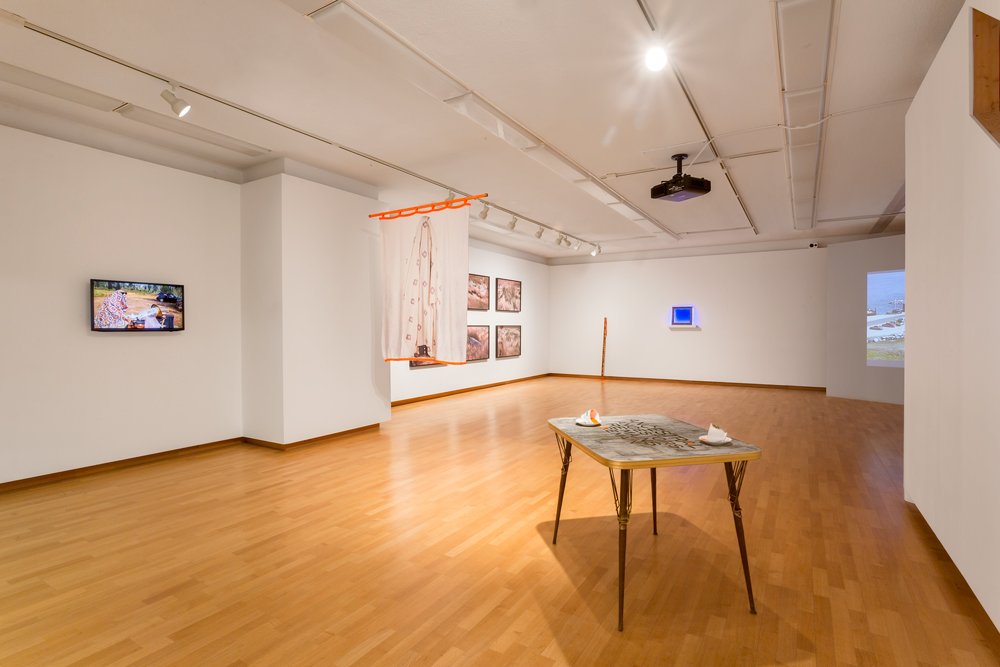How can we talk about haunting when we can’t even see it?
Moving beyond the typical ideas of ghosts found in popular culture and literature, curator Tarah Hogue suggests that haunting can be a way to rethink the colonial structures that persist in present-day Canada. Through haunting, Hogue argues that we can imagine “alternative futures” with “creative acts of sovereignty and cohabitation.” In “Unsettled Sites,” the latest group exhibition at SFU Gallery, Burnaby, guest curator Hogue brings together photography, video, sculpture and installation by artists Marian Penner Bancroft, Wanda Nanibush and Tania Willard. Each of the works looks at haunting either thematically or materially, particularly as haunting relates to the traumatic legacies of settler colonialism.
Artist Raymond Boisjoly and curator Jonah Gray recently made the trek up Burnaby Mountain to check out the show. In their ensuing conversation, which began on the car ride home, they questioned the ethical and aesthetic implications of the show and considered how individual works reflected the show’s themes, including the difficulty of narrating and documenting violent colonial histories, and the surveillance of Indigenous peoples.
Jonah Gray: When I viewed “Unsettled Sites” for the first time, I thought the show’s central dynamic involved works that either obscure or leave out Indigenous bodies. I’m beginning to rethink that now, though. What’s your take?
Raymond Boisjoly: That dynamic—the absence of Indigenous bodies—is most present in Tania Willard’s 2014 videos Listening and IBG, and the photograph To shadows and delusions here (2016), which use the clichéd depiction of a ghost: a bed sheet with holes for eyes. There is someone present in these works, but we can’t access the specifics of the person underneath. It’s not literally about the absence of Indigenous bodies, but about their spectral presence.
In Marian Penner Bancroft and Tania Willard’s works, there is a concern with the narration of history or the past. In Wanda Nanibush’s piece, Carrying, the idea of narrating history is complicated, because what we’re seeing involves a live video feed of the security camera from the band office in Chimnissing—something that is presently happening. It’s not a deferred presence; it is the very direct manifestation of these things in a distant place.
JG: And where Nanibush’s piece is a “live feed,” the other works are about dead people, literally and figuratively. You mentioned that you see a kind of a continuum between haunting and surveillance. What do you mean by that?
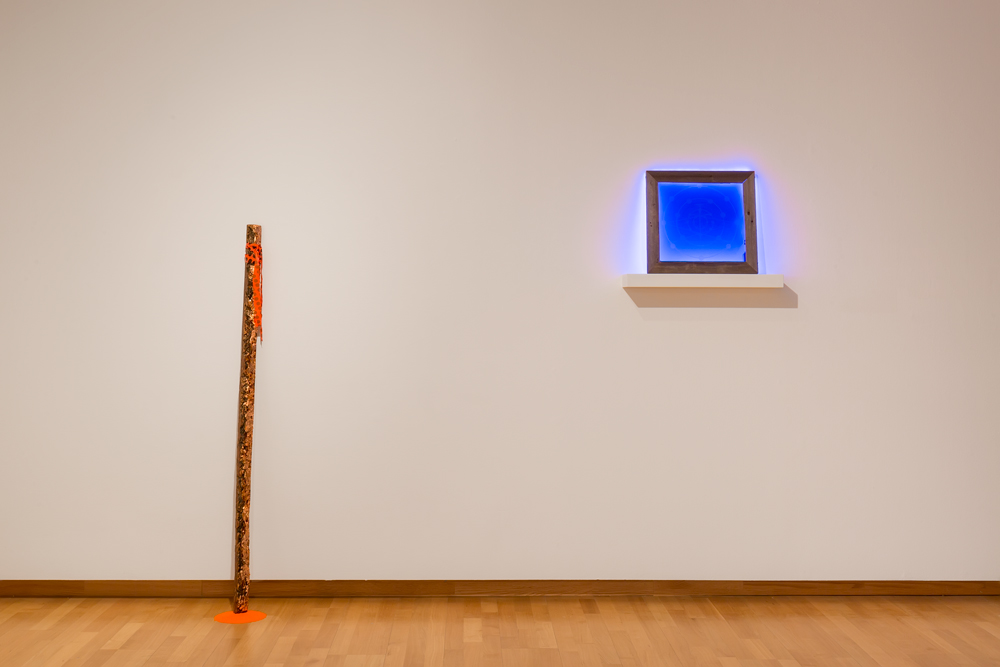 Tania Willard, This might be a sacred object, 2016 (left), and Protocol Anxiety (IBG), 2016 (right). Installation at SFU Gallery, 2016. Photo: Blaine Campbell.
Tania Willard, This might be a sacred object, 2016 (left), and Protocol Anxiety (IBG), 2016 (right). Installation at SFU Gallery, 2016. Photo: Blaine Campbell.
RB: I was thinking of Tania’s work with the LED lights, Protocol Anxiety (IBG) (2016), which uses this image from the 1989 film Pet Sematary that concerns the trope of the Indian burial ground as a source of haunting, like it’s an imperilled present that is ultimately suffering because of a historical wrongdoing, which is the mistreatment or destruction of indigenous peoples. I was thinking of it in relation to surveillance and paranoia. Haunting and anxiety, surveillance and paranoia; these things are ultimately manifestations of the same colonial circumstances. They might arise in relation to the past but they also concern the undoing of the future.
JG: It seems important to ask who is conducting the surveillance and who’s being watched in Carrying. But you can also ask those questions of the show more broadly. Who’s representing whom? What are the dynamics of representation?
RB: Those seem like open questions for so many of the works. These works might even be about an inability to represent. The concern with ghosts and haunting might be about the impossibility of representing these things. These are histories that have specifically been withheld.
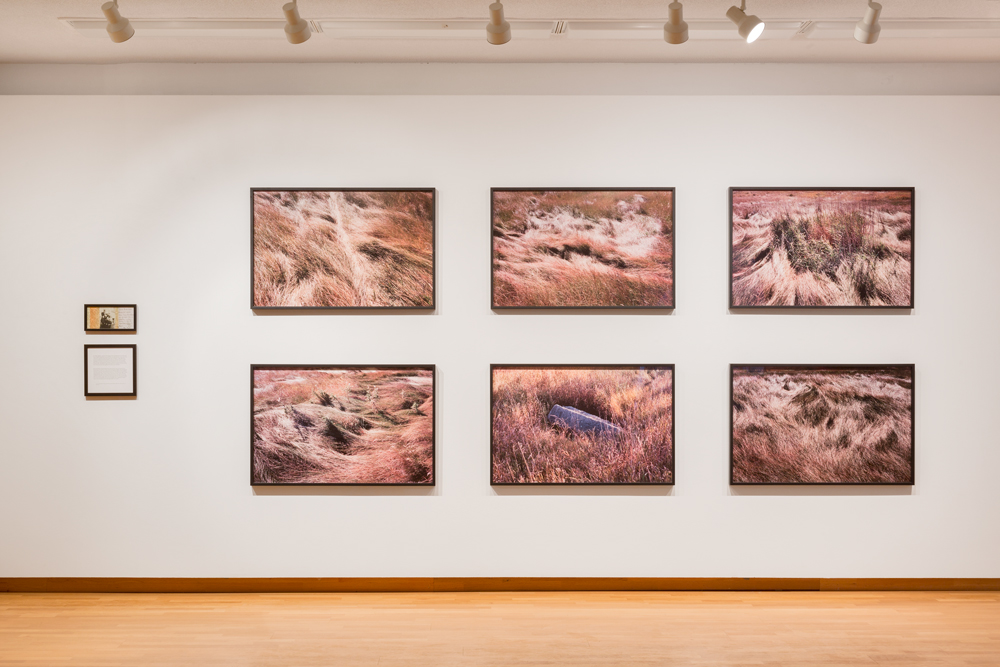 Marian Penner Bancroft, VISIT: Site of Former Indian Residential School, Birtle, Manitoba, 2000. Installation at SFU Gallery, 2016. Photo: Blaine Campbell.
Marian Penner Bancroft, VISIT: Site of Former Indian Residential School, Birtle, Manitoba, 2000. Installation at SFU Gallery, 2016. Photo: Blaine Campbell.
JG: I’m interested in the idea of the impossibility of representation. That seems like an apt reading of Marian’s VISIT: Site of Former Indian Residential School, Birtle, Manitoba (2000). She’s taken pictures of a place that no longer exists: a former residential school.
RB: It takes account of what remains and how these remnants might allow us to consider the complex ways people are implicated in these histories. The pictures offer a way of thinking about whose stories these are. How is it that their experiences can be carried forward and made available in a way that isn’t about occupying those experiences, but is instead about gesturing towards the difficulty of representing?
JG: Maybe it’s appropriate, then, that most of what we see in Marian’s photographs are just impressions in the grass.
RB: There’s an ambiguity to these photos: is it simply a stone, or is it a part of a foundation in there too? This ambiguity relates to anxiety, too. What is the purpose of bringing these images forward to be seen in relation to this complicated history? We are not shown the thing itself, we’re shown aspects of the site where the thing no longer exists. The focus is the complexity of the site itself.
JG: What do you make of the fact that the images themselves are really ambiguous? The pictures could have been taken anywhere, right?
RB: What happens when the actual place of these experiences is removed? How do we then organize our own concern for these things? What happens when a place is haunted by its history? How can we talk about something when we can’t even see it?
JG: This work also emphasizes the tenuousness of photography’s indexicality: this idea that photographs possess some irreducible trace of the real. This may be as close as we can get to that site and to that history in the sense that the same rays of light touched both that stone foundation and the film in Marian’s camera and then here we are looking at the prints, but it seems so tenuous.
RB: Their indexical character means that these photographic prints could participate from a distance in the history of that site and in the experience of the people at that site.
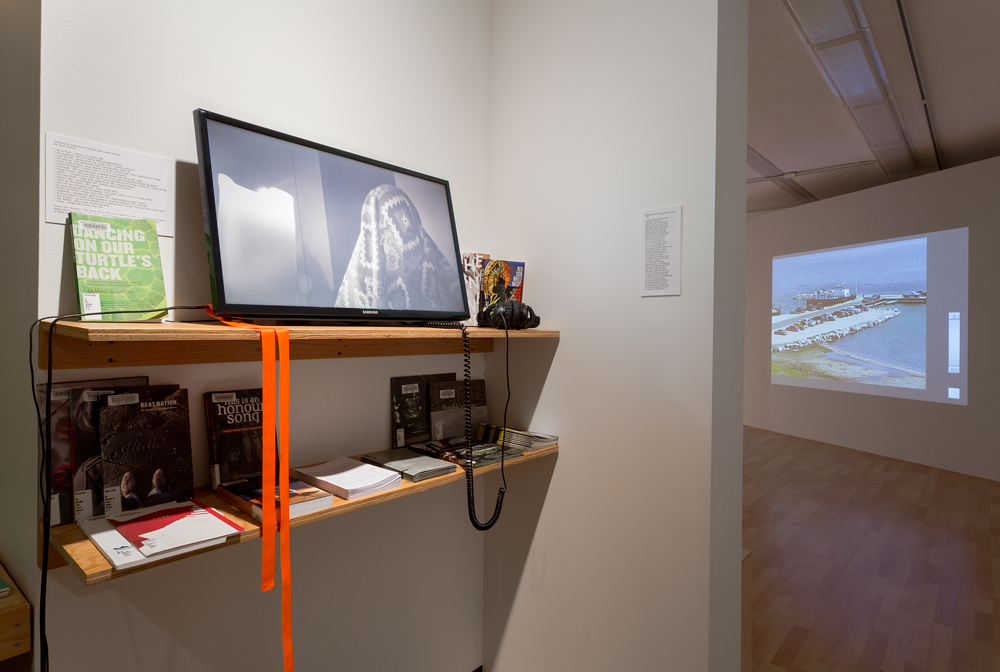 “Unsettled Sites” (installation view at SFU Gallery), 2016. Photo: Blaine Campbell.
“Unsettled Sites” (installation view at SFU Gallery), 2016. Photo: Blaine Campbell.
JG: On the flip side, Tania’s pieces—her video works and To shadows and delusions here (2016), a photograph printed on a fleece blanket—are less about the evidentiary qualities of photography and more about generating meaning with the camera. They use pop-culture constructions of Indian ghosts and Indian burial grounds as their basis, but then disrupt them.
RB: Which gives them this mediated character that highlights their material qualities: the clarity of the video or the soft surface of the fleece blanket. The piece trades on this sort of common representation of ghosts, but it seems to be about the humour of it.
JG: It actually makes me think of a strategy that I have noted in your own work of emphasizing mediation. If Marian’s work on some level is about mediation, it is also about the indexical character of photography. Tania’s work, on the other hand, layers all different sorts of mediation.
RB: In Tania’s video IBG, there is footage of a spinning ’78 record that knowingly acknowledges the way we encounter the past. Representations of the past manifest through different sorts of media. The only way we know how the Great Depression looked is because of Walker Evans’s photographs. A lot of this work concerns not only the representation of the past, but also the way that particular mediums inform our sense of the past.
JG: Tania is staging a reverse haunting! She uses this kind of cultural construction of Indian ghosts and Indian burial grounds and turns it on its head; making it laughable, not necessarily a subject of derision, but of satire.
RB: Yeah, while still recognizing that, while the burial ground or the ghost might be these cliché figures, there is a very real popular conception of historical wrongdoing contained within them. There’s a way this silly trope recalls the very real death and destruction wrought by colonialism, admittedly fictionalized in a convenient manner.
JG: Tania’s pieces aren’t all in this vein—there are three other works that don’t involve lens-based representation. This might be a sacred object, for example, is a piece of bark from a fir tree with copper leaf on it and survey tape wrapped around it. I don’t know if it does much for me.
RB: I think there’s the same ambiguity present in it; This might be a sacred object is like a shrug. The work involves certain materials associated with sacredness but then it’s wrapped together with survey tape, which complicates the idea of its sacredness. What is the contemporary possibility for the sacred? Could it include vernacular materials?
How can survey tape connote an idea of sacredness? These aren’t mutually opposed things. How is it that we can view these materials in a way that could be culturally meaningful—not simply in terms of charting the land or surveying the land to be used for destructive purposes—but somehow imbued with cultural relevance?
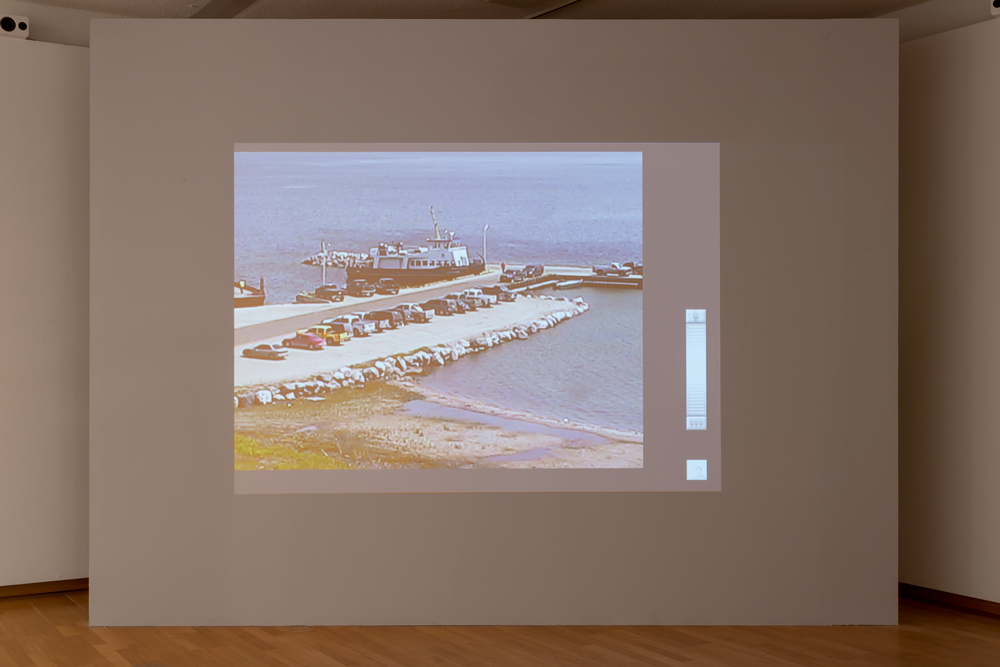 Wanda Nanibush, Carrying, 2010–16. Installation at SFU Gallery, 2016. Photo: Blaine Campbell.
Wanda Nanibush, Carrying, 2010–16. Installation at SFU Gallery, 2016. Photo: Blaine Campbell.
JG: All the pieces that we have talked about touch on these really broad historical or popular culture themes—like residential schools, burial grounds, notions of the sacred. But Wanda Nanibush’s video feed from the band office is focused on the ferry dock in this really isolated locale. Of all the works in this show, this is the one that I find most unsettling because all of a sudden you become the observer of these people who are just going about their day. Why are we watching them? What’s going on with that?
RB: It’s the only work that explicitly concerns the presence of the viewer because the audio is triggered when you pass through the gallery. There’s definitely an emphasis on the contingency of the present, on the ongoing character of things that we do not always have the convenience of historicizing. If it’s about haunting, it’s about the ongoing character, the dread of its ongoing character.
JG: It situates those problematics not just in history or the past. It situates them in the present. It makes me think of other cases of surveillance that are much less ambiguous and much more pernicious: for example, the surveillance of First Nations activists under the last federal government. That’s why I find it so unsettling. It’s uncomfortable to look at and it’s a bit uncomfortable to think about.
RB: The people we see in the projection are unknowingly roped into this without necessarily being aware of the uses of that feed.
JG: Yeah. They are being made the subject of an artwork without knowing it and perhaps without having an agency within that. The power dynamics at play in representation are really foregrounded in this work because, well, would the people in the feed act differently if they knew they were being watched?
RB: To understand what’s at stake in this surveillance, it’s important to consider who the people are that are being surveyed: are they Indigenous or non-Indigenous? The mundane movements of the people back and forth is given heightened importance when viewed in the art-gallery context; viewers are trying to understand what makes this meaningful. These peoples’ need to simply move from one place to another instead takes on this complexity.

